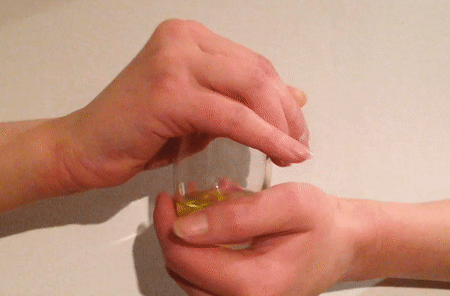How to Taste Olive Oil?
Now that we have learnt how to pick a good bottle of oil (if you haven’t read this article, click here) time has come to taste it!

What do I Use to Taste Olive Oil?
Professionals use dark blue glasses in a U shape, narrower at the top like Wine tasting
glasses, slightly smaller than small brandy glasses. I am sure you wonder how they judge the colour of the olive oil with a dark blue glass? In fact, colour doesn’t matter when judging olive oil, a greener olive oil isn’t going to be better than a paler one…
What Temperature Should You Taste Olive Oil at?
Olive oil will reveal all its aromas at 28°C (82.4°F for our dear friends overseas). Once again, professional tasters are well equipped and use a special machine to heat the glasses up. The easiest way to do it at home is to cover your glass with one hand to keep the scents inside and use the other hand to rub the bottom of your glass & warm it up.

Now Let’s Start!
Well, like wine, you stick your nose into the glass and breathe.
What do you smell? A Good EVOO should be grassy, bringing you to a huge field where they just mowed the lawn…or maybe reminding you of a ripe fruit, something like the smell of a ripe banana.
Remember that the smell must be clean and fresh.
If smelling the EVOO reminds you of the smell of your brother’s socks left on the couch for 15 days or the time that same older brother locked you up in a damp cellar when you were 10, it isn’t right! All these weird smells are called defects.
A list of negative/positive attributes can be at the end of the article.
Now You Can Finally Taste it!
Take a sip of the oil, let it roll on your tongue and gently drag some air in (small inhalations). The olive oil needs to swirl around your mouth for a at least 10 seconds before you can swallow it.
Same again, what can you taste? is it still fresh? Do you have any bad aroma coming through?
It can sometimes be easier to know what you should be looking for, look at the below list to find the most common defects:
Common Defects:
Fusty
Often caused because olives were left for too long into the bag/case before going to the mill. Stuck together with no oxygen, they started an anaerobic fermentation (one without oxygen). Will remind you of a damp basement.
Musty/Mouldy
Similar reasons to the above or sometimes the olives can be mouldy themselves, which will give this rotten/mouldy taste…
Muddy sediments
Some dirt or mud can sometimes stick to the olives, if left for too long before it is washed off, it can result in a specific defect, once processed through the mill. Will remind you of a barnyard.
Rancid
With time, olive oil turns rancid. Therefore, good olive oil must be consumed as close to the harvesting date as you can. Will remind you of a rancid nut or the smell of a crayon.
Winey/Vinegary
Olives started to ferment, developing a winey or vinegary aroma.
Desirable Traits:
Fruity
Well we tend to forget but olives are a fruit! Depending on the time of the harvest (the ripeness of the olive) the level of fruitiness will change…
For instance: green apple, pear, pineapple, banana peel, melon...
Bitter
Olives are bitter. Ever wondered why no one ever passed you a bowl full of raw olives when they invited you over! You couldn’t really eat raw olives, they are consumed either cured or pressed as olive oil.. Good olive oil will keep this bitter characteristic and this is good!
Pungent
It’s that real peppery taste you get at the back of your throat and that makes you cough. The fact that you cough is due to the phenols in the oil, which is a good thing that I will explain in more details very soon in another post about olive oil and good health!
Other ones:
Fresh Grass: well there is not that much to say for this one… I recommend you go to a park right after the grass has been cut…
Leaf &/or herbal aromas: dried thyme, tomato leaf…
Vegetables aromas: artichoke, tomato, bell pepper… However, cucumber can be the sign of a storage issue…
Dried fruits/nuts: walnut, almond…
A small advice on the above, if you want to be able to recognise the taste/smell of all these characteristics, I would recommend that you start smelling and tasting everything they remind us of (eat an artichoke, a bell pepper, a walnut, etc…).










